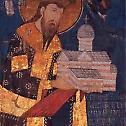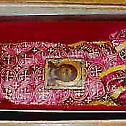The Life of St. King Stephen of Decani
St. King Stephen of Decani is one of the best known Saints of the
Serbian Orthodox Church. Through his holy and incorruptible relics God has performed numerous miracles.
Today, as the Serbian people suffer through another turbulent chapter in their history, they would do well to bring to mind the exemplary character of their martyred King Stephen Uros III (Decanski).
He was born the eldest son of the saintly King Milutin (Stephen Uros II) and his wife Elizabeth, a Hungarian princess. Living at the court of his parents, the heir-apparent received a good education, his mind exercised by study of the language and writings of his people, and his heart strengthened by study of the Holy Scripture and the teachings of the Orthodox Faith.
The good fruit of his upbringing proved itself when King Milutin was forced to send him as hostage to the Tartar chief Nogyi. In spite of the potential dangers, Stephen was obedient to his father's will and did not resist, trusting his life to the Lord. And his hope was not in vain. He eventually made friends with one of the Tartar nobles, who succeeded in assisting his safe return home.
When Stephen came of age, his parents arranged that he marry the daughter of the Bulgarian King Smilatz, and the young couple were given the land of Zeta, where they settled until such a time as Stephen would be called to succeed his father to the throne. Meanwhile, King Milutin had remarried, and his second wife, Simonide, plotted in order that their son Constantine inherit the throne. She convinced Milutin that Stephen wanted to seize the throne prematurely, and the deceived Milutin ordered that his son be captured, that he be blinded to ensure that he never again entertain such treachery, and that he be sent as a prisoner to Constantinople.
The prince was taken together with his children, Dusan and Dusica, and when they were passing through Ovcepole (Sheep's Field), the guards took red hot pokers and blinded him. That night St. Nicholas appeared to Stephen in a dream: "Be not afraid," he said, "your eyes are in my hands." Comforted not a little by this vision, the sightless Stephen arrived in Constantinople. The Emperor Andronicus pitied the young exile, and received him graciously. He was soon settled in the monastery of Pantocrator, where he impressed the monks by his meekness and his longsuffering acceptance of the bitter trial that had come to him through his own father.
Five years passed. King Milutin was growing old. Hearing good reports about his son, his heart softened, and he called Stephen home to Serbia. Before leaving Constantinople, Stephen had a dream in which St. Nicholas appeared to him a second time, holding in his hand a pair of eyes. When he awoke, his sight was restored.
Three years later, his father died, and Stephen, always popular with the people, was crowned King of Serbia by the holy Archbishop Nikodim in the church at Pec. His halfbrother, Constantine, resented this turn of events, and raised an army in order to wrest the throne away from Stephen. Desiring to avoid bloodshed, King Stephen addressed a letter to Constantine:
"Put far from thee thy desire to come with a foreign people to make war on shine own countrymen; but let us meet one another, and thou shalt be second in my kingdom, for the land is great enough for me and thee to live. I am not Cain who slew his brother, but Joseph who loved him, and in his words I speak to thee. Fear not, for I am from the Lord. You prepared evil for me, but the Lord has given me good, as you now see."
Constantine was unmoved and gave orders to attack. In the ensuing battle, his army was defeated and he himself was slain. For the next ten years, King Stephen ruled in relative peace, and the Serbian land prospered. His son Dusan proved to be an able military leader and was successful in battles with the Bulgarians and the Greeks, who were envious of the now powerful Serbian state and rose up against it. Grateful to the Lord for these victories, King Stephen set about with Archbishop Daniel, Nikodim,s successor, to find a place to build a church. They settled upon a place called Decani, and there, in 1327, King Stephen himself laid the cornerstone for what was to become one of the most magnificent and enduring specimens of Serbian church architecture. Inside it was graced by splendid icons, to which more were added in the sixteenth century by the hand of the celebrated Slav iconographer, Longinos.
Saint Stephen gave generously to the needy. He also made liberal donations to churches and monasteries on the Holy Mountain, in Jerusalem, Alexandria, and to the monastery of Pantocrator in Constantinople. Nor did he forget his debt to the wonderworker Nicholas: he commissioned a silver altar and sent it together with some icons to the church in Bari, Italy, where the Saint's holy relics are located.
Having in a true Christian manner endured the grievous trials and afflictions which he met through the years, the good king deserved to live out the rest of his life in peace. But it was only fitting that he who suffered as a martyr in life should be granted an opportunity to receive in death a martyr's crown. His final trial was the most agonizing. Dusan's successes on the field of battle had given him an appetite for power and glory, and, encouraged by his entourage of nobles, he decided to hasten his father's death. In 1331, St. Stephen was taken prisoner to a fortress in the town of Zvecan and cruelly murdered (by some accounts he was hung, according to another he was strangled).
Almost immediately Dusan was struck by remorse. He earnestly and tearfully repented of his treachery, and the next year, on the feast of the Holy Apostles Peter and Paul, he had his father's remains transferred from Zvecan to Decani, where they were placed in a marble tomb. In 1339 the tomb was opened, and his body was found to be incorrupt. That same day saw many miracles of healing. Especially did the holy king prove to heal diseases of the eyes, and at his relics blind people received their sight.
by Fr. Kozma Vasilopoulos
The Orthodox Monastery of St Michael, Sidney





